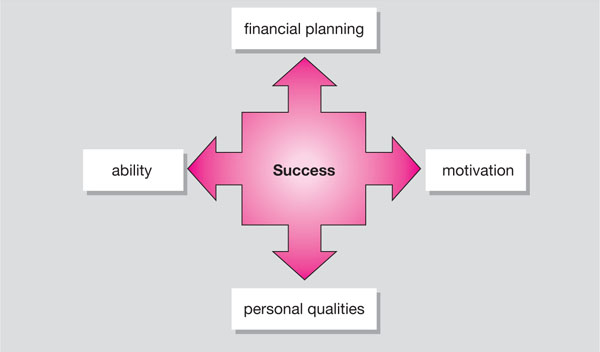Chapter 2
Success Factors
Success in business is rarely accidental or incidental. It should be a planned outcome. In dentistry, it is a function of your reputation and your business acumen; combine the two and you will experience synergy at work. Your professional reputation will play a big part in the success of your business and the best way to gain a good reputation, according to Socrates, is “to endeavour to be what you desire to appear”.
What is Success?
Howard Whitman wrote, “Success is no straitjacket. It is no mould into which all must be poured. It is no rigid stamp. It is as individual as our fingerprints or the look in our eyes.” In other words, success should be about what you want to achieve in your chosen profession. There is no magic formula, but there is a recipe because success for most dentists is a blend of the following:
-
professional status
-
postgraduate qualifications
-
financial security
-
personal life-style
-
family matters
-
freedom of choice.
This list is not intended to be exhaustive or indeed given in order of preference. It represents a number of destinations, all of which are part of a professional and personal journey.
Metrics are important – we all need to know where we are, where we are going and how long it will take to get there. Prioritise your destinations and then plan the route. Stay focused, because, as someone once said, the road to success is lined with many tempting parking spaces.
Critical Success Factors
Critical success factors are those things that an organisation must be successful in achieving in order to grow, become viable and flourish in the commercial marketplace. In other words, they are the factors most responsible for your practice’s success. The future prosperity of your practice will depend on them. Business failure is usually the result of one (or, frequently, a combination) of the following:
-
Lack of planning.
-
Setting unrealistic expectations.
-
Not understanding the customer. (Changes in your patients’ preferences and your competitors’ products and services can leave you behind the curve.)
-
Getting wedded to an idea and sticking with it for too long. (Do not marry a single idea. Remember that ideas are the currency of entrepreneurs. Play with many ideas and see which ones produce positive outcomes.)
-
No Marketing Plan. (A marketing plan creates the kind of attention you need to get in front of the right types of people, companies, etc.)
-
Ignoring Employees. (Expenditure on the team is an investment and not an unnecessary expense. Motivating, coaching and managing your staff are probably the toughest challenges in any business. Lack of morale and motivation can rapidly erode profits.)
-
Confusing likelihood with reality. (The successful entrepreneur lives in a world of likelihood but remember that expenditure takes place in the world of reality.)
-
Not moving with the times. (Where your business is today is down to what you did yesterday. Times change, so remember that yesterday’s success was based on yesterday’s strategy and that is no guarantee that tomorrow will be the same.)
-
Focusing on new customers and ignoring your existing ones.
-
Fear of change.
In general terms, business success relies on focusing on the four Cs:
-
controls and measurement
-
cost analysis
-
cash management
-
customer care.
The four Cs are also central to this book.
When patients return to seek their care and treatment at your practice, they bring you business. They do so for a number of reasons, but there are usually only a few critical ones. Without these, they would not come to you. There may be other reasons, but they may not make a lot of difference. When dentists are asked why patients continue to come to them the reasons most often cited are:
-
The patients are given good value.
-
The dentists are reliable.
-
The quality of dentistry is good.
-
There is a high level of customer care.
Now take a look at any practice information leaflet or read any advertisement in a business directory and you find that most practices (if not all) list the above as key features of their practice. Patients hear and read the same things from everyone. So what makes your practice special?
Identify your critical success factors by following the sequence shown in Table 2-1. Factors common to all practices are shown in Table 2-2. Every dentist has one critical success factor unique to their practising environment and one that no one else can ever copy. That factor is you.
| Step 1 Ask your patients |
You want to concentrate on areas that your patients find critical and which make them choose you. The best way to do this is to ask them! They will give you feedback and tell you what they would like to see.
Once you have discussed your practice with some of your most loyal and valued patients, you will notice a pattern -groups of patients will value the same things. |
| Step 2 Measure |
Your next step is to establish a measurement scale for each critical factor. Everything is measurable, you just need the right system. Some of these measures will be quantitative and some qualitative.
Gross fee income is an easy one – measuring revenue measured against realistic targets and budgets for expenditure. The number of new patient inquiries is also something that is easy to measure. |
| Step 3 Set the baseline be |
Once you’ve established a measurement structure for a factor, the next step is setting a baseline. Each factor should set against a scale ranging from 1 to 10. Subjectively this can translate into poor performing (1), poor (2–3), mediocre (4–5), good (6–7), excellent (8–9), and exemplary (10).
You decide on the scoring and we must accept that this is a subjective process. |
| Step 4 Set new goals |
You should now create a “gap” between where you are – your baseline – and your target for that factor. If you want to control expenditure in a certain area of your practice, your current position may be 5 but you want to aim at 8. The same approach can apply foe developing your clinical skills and staff training initiatives. Your goals will have an impact on how you allocate your resources and energy.
To help you prioritise which areas you want to focus on, look at return on investment, required resources, scheduling conflicts, time to impact, total cost, and likelihood of success versus risk of failure. |
| Step 5 Close the gap |
You now have a baseline and a target for each factor and your challenge is to close it. Ask the question: What will close the gap between our current level of this factor and our desired level? What actions are required to raise the subjective measurement to meet the target? |
|
The success of your business depends initially on the financial framework that has been put in place to support it (Fig 2-1), but then on your motivation, your ability and your personal qualities – the MAP for your unique journey.

Fig 2-1 Financial framework of your business.
Ability
Ability is made up of knowledge skills and attitude, and in the business of dentistry attitude is much more important than aptitude. The first and most important thing you need to acquire in order to succeed in the business of dentistry is knowledge. According to research conducted by Dun and Brad-street, one of the world’s leading providers of business information, 90% of all small business failures can be traced to poor management resulting from lack of knowledge. You need to be knowledgeable about
-
Your profession (the clinical and non-clinical aspects).
-
Your business (its products and services, priorities, financial requirements).
-
Yourself (your strengths, weaknesses, goals, attitude to risk-taking).
-
The marketplace (its relevance, size, new developments, socio-economic influences).
-
The competition (who they are, what they offer).
Your knowledge and experience should become a springboard for innovation. Without this, you and your business cannot develop. The very knowledge and experience that helped get you where you are can paralyse your potential for progress. Your skills will include clinical skills as well as strategic skills. Strategic skills are those that enable you to take a broader view of your business and to develop a vision and a goal. In short, to keep the vision on track.
To illustrate this, consider the following exercise developed by psychologist Carl Drucker. Look at the nine dots in Fig 2-2. The challenge is to connect all the dots with four straight lines without lifting your imaginary pen from the page once you have begun. The solution can be seen in Fig 2-3. To achieve the desired outcome you had to leave the imaginary box formed by the outline of the outer dots.

Fig 2-2 Exercise developed by psychologist Carl Drucker.

Fig 2-3 All the dots connected by four straight lines.
In their book Think Out of the Box, Vance and Deacon propose a series of questions to ask about any project. They call this “The Concept of Nine”.
-
Assess the way things are.
-
Seek realistic thinking.
-
See the vision.
-
Ask why.
-
Becom/>
Stay updated, free dental videos. Join our Telegram channel

VIDEdental - Online dental courses


